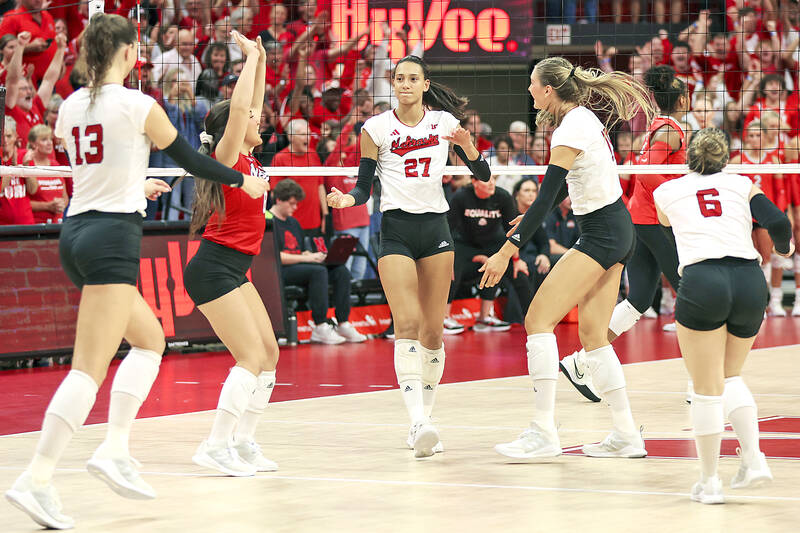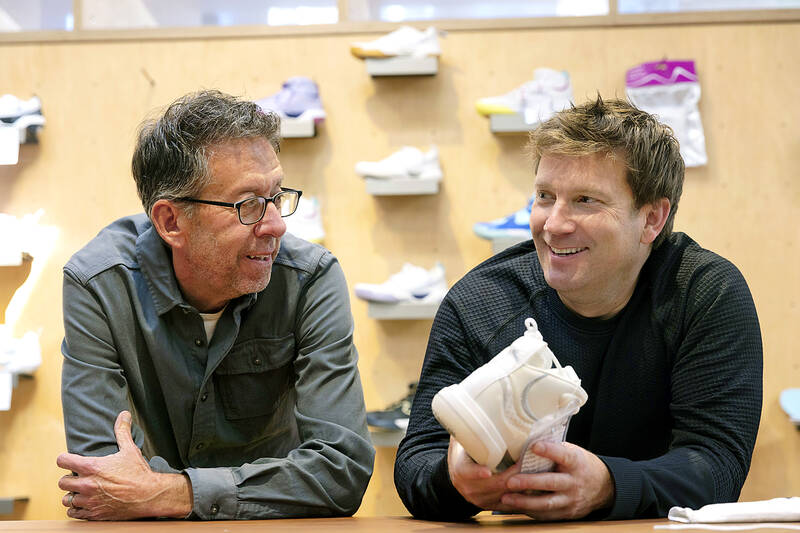Harper Murray puts on her Adidas AG volleyball shoes when she practices or plays in a match for Nebraska, one of the top teams in the country. It is not necessarily the brand she would choose; it is because the German company is her school’s official supplier, and athletes, coaches and staff are required to wear its products.
Texas’ Reilly Heinrich and Virginia’s Ashley Le wear Nike Inc shoes because their schools are under contract with the shoe giant. Heinrich actually wears basketball shoes bearing the familiar swoosh because she says they fit better than Nike’s volleyball shoes.
All three also are brand ambassadors for a new volleyball shoe brand, Avoli, which they promote on social media platforms as part of their name, image and likeness compensation deals with the start-up based in Portland, Oregon, also the hometown of Nike.

Photo: AP
The three can tout Avoli all they want, but it is highly unlikely they would ever wear the brand when they actually represent their schools in competition — a familiar and seemingly immovable hurdle for athletes in many college sports. While they now have the freedom to earn money from name, image and likeness (NIL) endorsements, they remain beholden to terms of apparel contracts paying millions to their schools and nothing to them.
For example, Adidas gives Nebraska US$4.85 million in cash and more than US$6 million in product this year, the seventh in an 11-year contract with a total value of US$128 million.
Murray, the No. 1 high school recruit last year and already one of the top players for the nation’s second-ranked team, said she accepts she must wear Adidas as part of playing for the Cornhuskers.

Photo: AP
“I think if I had the option to wear another shoe, I’d 100 percent pick Avoli,” she said. “Obviously, that’s not really an option.”
College athletes should be able to wear shoes of their choice, said Ramogi Huma, the executive director of the advocacy group College Athletes Players Association.
Limiting athletes to the brand with which their school is affiliated creates two problems, he said. First, it prevents athletes from achieving their full NIL earning potential, because they cannot wear the shoes in competition, when they get the most attention. Second, an athlete’s performance could be compromised if the shoes they are wearing do not fit properly.
“It’s a health and safety issue,” Huma said. “If your foot is being squeezed, that’s a problem. Look at volleyball players. A lot of them are tall, and they may have wider feet than the average person. Everybody is made differently.”
Footwear is an issue in any sport, but the movements associated with volleyball make it critical to have the right fit, Le said.
“Volleyball is one of the most jumping-related sports,” she said. “The shoe — especially with ankle stability and the ability to move laterally and vertically without feeling in danger of hurting yourself — is very important.”
It would be rare for a college athlete to wear a shoe other than the school sponsor’s brand.
For example, the Adidas contract with Nebraska says if an athlete experiences injury, pain or discomfort serious enough to affect performance, Adidas is given an opportunity to remedy the problem. If the problem persists, the athlete can wear another brand, but its logo must be covered.
Nike contracts have similar language. Typically, an independent physician must verify the athlete’s need for an exception.
Missouri in 2021 considered, but did not pass, an amendment to its NIL state law that would have allowed athletes to wear shoes of their choice in mandatory team activities. New Mexico passed a bill last year giving athletes freedom to choose their shoes but that language was removed during this year’s session.
New Mexico Senator Antonio Maestas, one of the original bill’s cosponsors, said he did not know how that happened.
Murray said she has switched between volleyball and basketball shoes over the years.
Heinrich said she wore volleyball shoes she did not really like when she was a high-school and club player and settled on Nike basketball shoes at Texas because she found they gave her foot more support.
Le has worn volleyball shoes since she was little, mainly because she found basketball shoes to be too heavy and wide for her.
The athletic shoe giants all have lines of volleyball shoes, but Avoli cofounders Mark Oleson and Rick Anguilla said their brand is fully dedicated to what they believe is an underserved market.
A feature of the Avoli shoe are tiny holes in the soles to provide ventilation, something young players said they wanted.
Oleson and Anguilla, who have years of experience in various aspects of the athletic shoe business with different brands, declined to criticize their giant competitors.
“Are they making bad volleyball shoes?” Oleson said. “I would say what we’re doing is we’re making a very specific volleyball shoe for the female athlete, how she moves, jumps, squats, pivots, dives and how she’s basically going to live throughout her entire tournament.”
Adidas spokeswoman Sophie LeRoux said in an e-mail that her company’s volleyball shoes are “built with a women’s first approach” and designed in collaboration with professional and amateur players.
Adidas has partnerships with volleyball federations in Europe and China, as well as throughout North America.
LeRoux declined comment on the company’s sponsorship contracts with colleges, while Nike did not respond to messages.
Avoli is content to sell its volleyball products to younger players and is not worried about penetrating the college sponsorship market, Anguilla said.
“With somebody like Harper Murray or any of the athletes we’ve signed to NIL deals, they’re reaching 25, 50, 100,000 people on their social media,” Anguilla said. “When we start thinking about the audience, NIL is going to really impact the value of those all-school contracts long-term. If we can use athletes to bring awareness to our product, and if the product is great, we like that equation.”
That does not help athletes who cannot wear the shoes they would like in competition.
Harper said that she has no problem with Adidas shoes — she just likes the support and feel of her Avolis better.
The matter of shoes is personal to Huma, a former University of California, Los Angeles football player who said he had to have foot surgery in 1996 because of ill-fitting shoes.
Huma said college athletes should get a cut of the revenue from school apparel contracts and that, as partners with the schools, athletes could agree to wear socks, wristbands, headbands and other accessories under those contracts.
Shoes, Huma said, are different because certain brands do not always provide an optimal fit.
“Wearing the same jersey isn’t going to be an issue when it comes to your health,” he said. “Shoes? That matters a lot.”

Taiwan Semiconductor Manufacturing Co (TSMC, 台積電) last week recorded an increase in the number of shareholders to the highest in almost eight months, despite its share price falling 3.38 percent from the previous week, Taiwan Stock Exchange data released on Saturday showed. As of Friday, TSMC had 1.88 million shareholders, the most since the week of April 25 and an increase of 31,870 from the previous week, the data showed. The number of shareholders jumped despite a drop of NT$50 (US$1.59), or 3.38 percent, in TSMC’s share price from a week earlier to NT$1,430, as investors took profits from their earlier gains

In a high-security Shenzhen laboratory, Chinese scientists have built what Washington has spent years trying to prevent: a prototype of a machine capable of producing the cutting-edge semiconductor chips that power artificial intelligence (AI), smartphones and weapons central to Western military dominance, Reuters has learned. Completed early this year and undergoing testing, the prototype fills nearly an entire factory floor. It was built by a team of former engineers from Dutch semiconductor giant ASML who reverse-engineered the company’s extreme ultraviolet lithography (EUV) machines, according to two people with knowledge of the project. EUV machines sit at the heart of a technological Cold

CHINA RIVAL: The chips are positioned to compete with Nvidia’s Hopper and Blackwell products and would enable clusters connecting more than 100,000 chips Moore Threads Technology Co (摩爾線程) introduced a new generation of chips aimed at reducing artificial intelligence (AI) developers’ dependence on Nvidia Corp’s hardware, just weeks after pulling off one of the most successful Chinese initial public offerings (IPOs) in years. “These products will significantly enhance world-class computing speed and capabilities that all developers aspire to,” Moore Threads CEO Zhang Jianzhong (張建中), a former Nvidia executive, said on Saturday at a company event in Beijing. “We hope they can meet the needs of more developers in China so that you no longer need to wait for advanced foreign products.” Chinese chipmakers are in

AI TALENT: No financial details were released about the deal, in which top Groq executives, including its CEO, would join Nvidia to help advance the technology Nvidia Corp has agreed to a licensing deal with artificial intelligence (AI) start-up Groq, furthering its investments in companies connected to the AI boom and gaining the right to add a new type of technology to its products. The world’s largest publicly traded company has paid for the right to use Groq’s technology and is to integrate its chip design into future products. Some of the start-up’s executives are leaving to join Nvidia to help with that effort, the companies said. Groq would continue as an independent company with a new chief executive, it said on Wednesday in a post on its Web